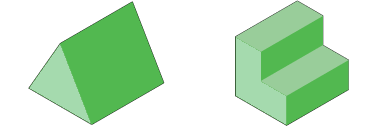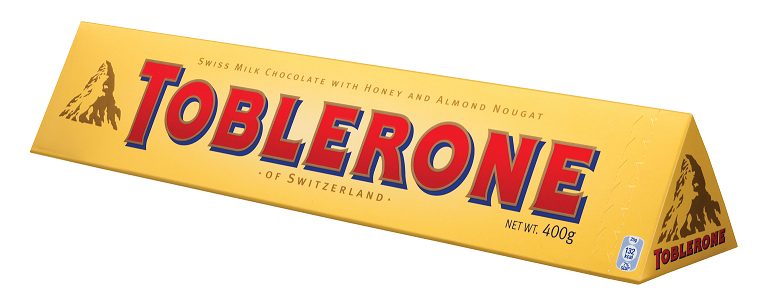12.13 Visualising solids
Three-dimensional objects are represented on two-dimensional surfaces all the time. Screens, whiteboards, paper, and other flat surfaces can create the illusion of depth when displaying a picture of something.
There are a few tricks we can use to think about three-dimensional objects represented on a flat surface.
Nets
We can never see every part of a three-dimensional object at once - there is always part of it that is behind the view we are looking at. To better think about a solid object we sometimes represent it with its net. Each face of the solid is laid flat on the same surface, breaking it along the edges and folding it out. This way we can think about folding it back up along its edges to recover the original shape.
Here is a triangular prism. Move the slider to see its net unfold:
There are many ways to unfold a net from a solid, and in this chapter we will investigate nets of prisms and pyramids.
Here are some prisms:
| Prisms | |||||
|---|---|---|---|---|---|
 |
 |
 |
 |
 |
 |
| Triangular | Square | Rectangular | Pentagonal | Hexagonal | Octagonal |
Prisms have rectangular sides, and the shape on the top and the base is the same. The name of this shape gives the prism its name. Any cross-section taken parallel to the base is always the same.
Here are some pyramids:
| Pyramids | |||||
|---|---|---|---|---|---|
 |
 |
 |
 |
 |
 |
| Triangular | Square | Rectangular | Pentagonal | Hexagonal | Octagonal |
Pyramids have triangular sides, and the shape on the base gives the prism its name. Any cross-section taken parallel to the base is always the same shape, but is smaller in size than the base.
Practice questions
Question 1
Choose the net that folds to give the shape below:
- ABCD
Question 2
Choose the shape that has the following net:
- ABCD
Front, side, and plan view
Three-dimensional objects can be represented with the side elevation, front elevation, and top elevation (called plan) clearly indicated on a two-dimensional surface. We can then ask about the view from each of these elevations.
Worked example
example 1
Consider this solid formed from cubes:

What is the front view? We can colour the sides of the cubes that are facing the front to make an image like this:

We can now piece together the front view by joining the highlighted faces together:
 |
| Front view |
We can do the same from above:

Looking up and over from the side, we can tell that this is the plan view:
 |
| Plan view |
When thinking about the side view, we can again use the same trick:

However, this time there is a highlighted face that would be hidden from the side that we don't include:

Once we have identified this hidden side, we can draw the side view properly:
 |
| Side view |
Practice question
Question 3
Consider this solid formed from cubes:
Which of the following diagrams represents the plan view?
ABCWhich of the following diagrams represents the side view?
ABCWhich of the following diagrams represents the front view?
ABCD
3D shapes
Vertex (plural is vertices)
A vertex is a point where two or more straight lines meet. Otherwise known as a corner.
This rectangular based pyramid has $5$5 vertices.

Edge
An edge is a line segment that joins two vertices.
This rectangular based pyramid has $8$8 edges.

Face
A face is any of the individual surfaces of a solid object. This rectangular based pyramid has $5$5 faces.

Types of 3D shapes
Polyhedra
A polyhedron is the 3D equivalent of a polygon. Remember how a polygon is a many angled (many straight sided) figure. Well a polyhedron is a many sided flat faced figure. A polyhedron has no curved edges and each face is a polygon.
Here are some examples of 3D solids that are polyhedra:

These ones are not. These all have curved faces or edges.

Prisms
A prism is defined as a solid geometric figure whose two end faces are similar, equal, and parallel. These are both prisms. Prisms need to have all straight edges and faces, no curves.

A prism has a base and a uniform cross-section. The base is one of the two parallel identical ends. The bases for these prisms are shaded blue.

A uniform cross-section means that if we slice the solid (imagine cutting it liked sliced bread) at any point parallel to the base then it will have the exact same shape as the base.
Prisms occur very commonly in the packaging of grocery items, and finding the volume of these contributes to the design, shape and size of packaging and product.



Cube
A rectangular prism with all $6$6 faces being squares is called a cube.

Cylinder
A cylinder is similar to a prism, it has two parallel circular faces. It also has a uniform cross-section. It is not classified as a prism because of the circular edge and face.

Pyramids
A pyramid can be made in the following way:
- Use any polygon as a base. We can have square bases, triangular bases or even hexagonal bases.
- Then connect every vertex of the base to an apex point above the base, and you have a pyramid.

We can name a pyramid by the shape of the base. Here are some examples of square and rectangular based pyramids in real life.
![]()


Cones
A cone is made by connecting a circular base to an apex. Such as the right-cone shown below:
Spheres
A sphere is made by having a central point and then creating a surface where all points on the surface are the same distance from the centre.
Sports balls and planets may come to mind when we think of spheres.
![]()
![]()
![]()

![]()
![]()
![]()
Now that we know how to name a solid, the next step is to understand some of the language that is used to describe them.
Classifying 3D shapes
Regular solids
Regular solids have faces that are all identical and the same number of faces meet at each vertex. There are only $5$5 regular solids and they are given the special name: the Platonic solids. The most familiar regular shape is a cube, where each face is a square and three squares meet at each vertex. Notice the names of these commonly have -hedron at the end. All other polyhedrons are known as irregular solids.

The $5$5 Platonic solids
Convex or concave
As we saw for 2D shapes, describing flat shapes as convex or concave came down to identifying if there was a cave-like shape to the edges.
For 3D solids, the idea of concave and convex is the same.

Right or oblique
A right solid is one that has its axis at right angles to its base.
- Right cone, has its apex at right angles to the centre of the base.
- Right pyramid, has its apex at right angles to the centre of the base.
- Right prism has the central line (axis) at right angles to the centre of the base.
- Right cylinder has the central line (axis) at right angles to the centre of the circular base.
These solids are all right solids and notice the red axis line that shows it is perpendicular to the base.
These solids are all oblique solids, notice the red axis line that shows its angle to the base.
- If the solid has a uniform cross-section it is a prism. We name it by identifying the base, (or the shape of the cross-section) and the word prism. eg rectangular prism, triangular prism, hexagonal prism, trapezoidal prism
- If the solid has $2$2 parallel circles as edges, we call this a cylinder.
- If the solid has $6$6 sides and all of them are squares, we call this a cube.
- If the base is a polygon, and all the vertices are connected to a common apex then it is a pyramid and we name it by using the name of the shape that the base is and using the word pyramid. e.g. rectangular pyramid, triangular pyramid, octagonal pyramid
- If the base is a circle, and it connects to a point we call this a cone.
- If each point on the surface is equally distant from the centre, we call this a sphere.
Practice questions
Question 4
Select the right name for each solid:
Square pyramid
ATriangular pyramid
BTriangular prism
CSquare prism
DRectangular prism
ASquare pyramid
BSquare prism
CRectangular pyramid
D
Question 5
Classify the following solids as convex or non-convex:
Does the shape have a uniform cross-section ?

No
AYes
BIs the solid convex or non-convex?

Convex
ANon-convex
B
Question 6
Here is a rectangular prism.

How many faces does it have?
How many vertices does it have?
How many edges does it have?
Rotational symmetry of solids
If a solid can be rotated about a straight line so that it fits into itself, it has rotational symmetry. The straight line is called its axis of symmetry. For instance, the hexagonal prism below, can rotate and fit into itself six times before it is in the same position as when it started. That means it has rotational symmetry of order $6$6:
The following cylinder can rotate and fit into itself about its axis of symmetry an infinite number of times before getting back to its original position. So we say it has rotational symmetry of order infinity.
Worked example
example 2
State the order of rotational symmetry for the rectangular prism below about the given axis of symmetry.
If we rotate the rectangular prism $$ clockwise about the line so that corner$B$B lies where corder $D$D is, we get the following:
So the prism fits into itself. Now we can rotate the prism another $$ it will also fit into itself and be in its original position:
So it fit into itself twice, which means it has rotational symmetry of order $2$2.
Plane symmetry of solids
A solid has plane symmetry if it can be divided into half by a two-dimensional plane (or you could think of it like a sheet of paper cutting through the solid to divide it into halves). A triangular prism is shown below, with a plane of symmetry cutting it in half:
These are just some of the planes of symmetry for a cube:


















